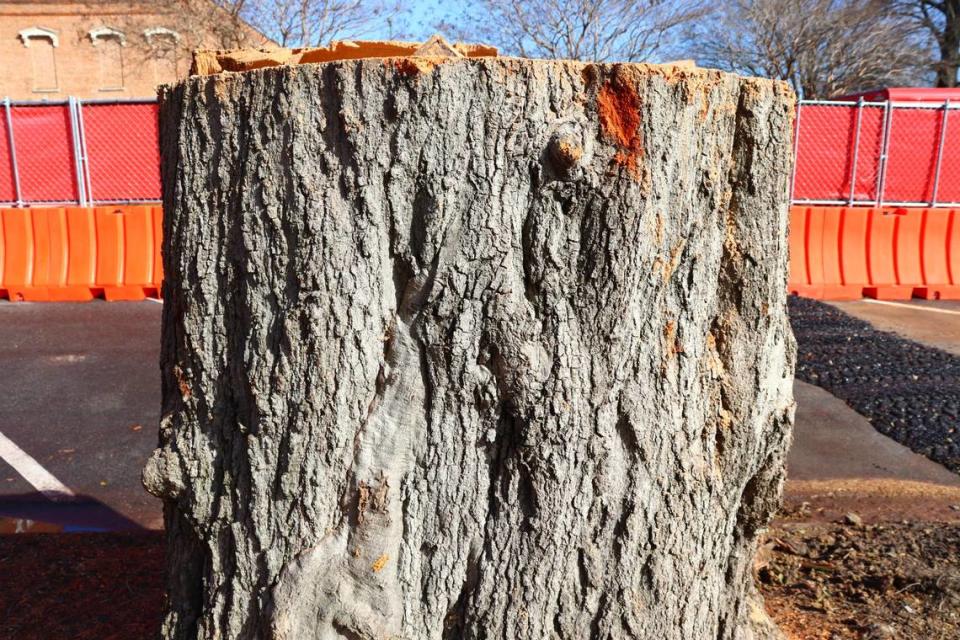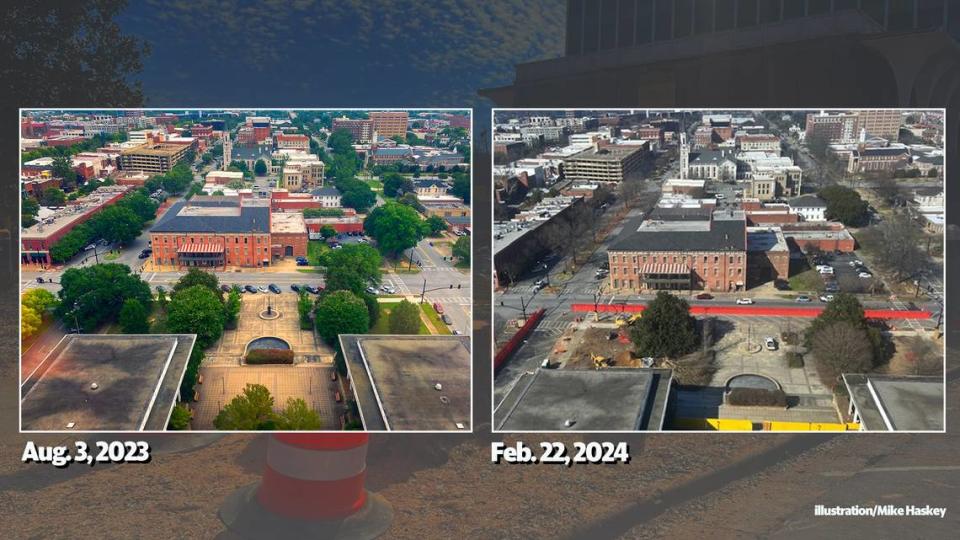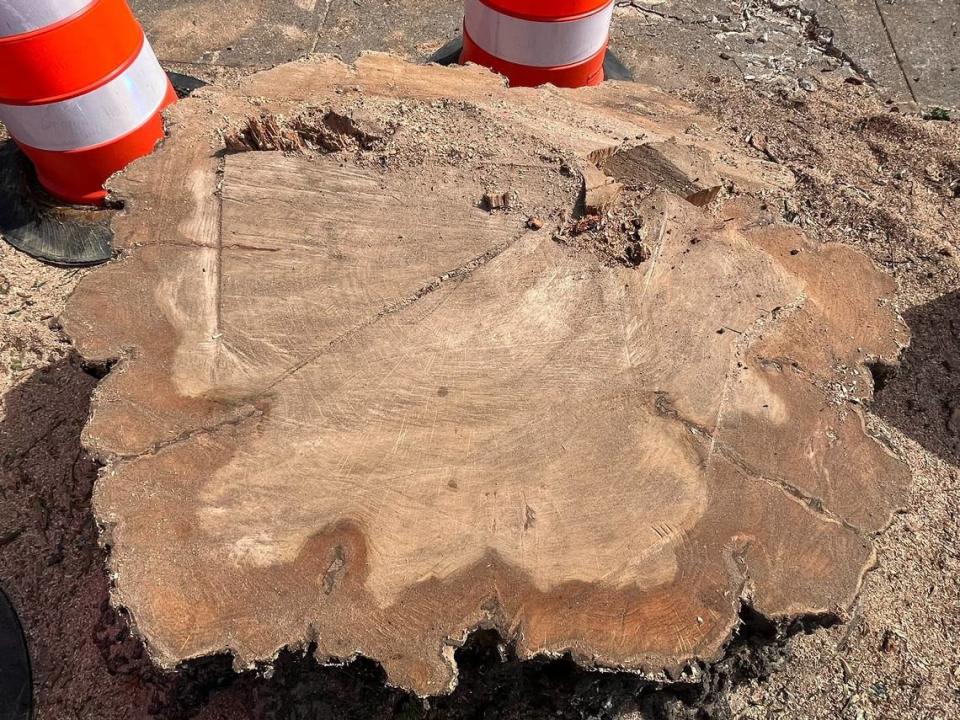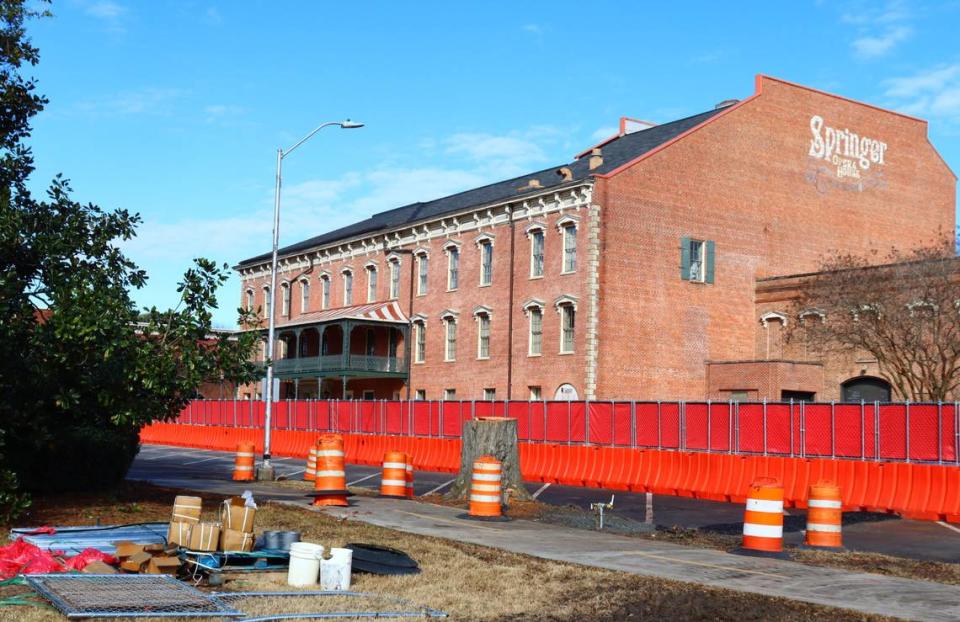Historic trees cut for new Judicial Center project. It violates Columbus tree ordinances
An elderly tree was cut down in the name of progress. But residents want answers about who approved the felling.
What is known it that orange construction partitions began lining the grounds of 10th Street and First Avenue at the Columbus Judicial Center last Wednesday, accompanied by trucks and chainsaws. They were there to remove centuries-old trees to make way for a new building.
There is just one problem: cutting down any city trees requires a tree plan before demolition or construction begins. And there is no tree plan in sight.
The city is violating its own tree ordinance (Article 6, Tree Preservation and Replacement, Section 4.6.9 and Section 4.6.12. E and F) requiring a plan be in place before any construction can begin.
After several attempts to speak with the city arborist, the Ledger-Enquirer was never given permission from various Columbus officials.
Nor did the city apparently reach out to the group responsible for tree planting and protection.
“The city did not consult us,” said Dorothy McDaniel, executive director of the nonprofit group, Trees Columbus. “If they had, it would have allowed us to say you are not abiding by the tree ordinance unless you provide a tree plan. That goes for demolition too (see section E and F of above). A 90-year-old tree is significantly old for an urban tree.”

The tree ordinance was established in 2002 by Trees Columbus. At that time, Councilman Glen Davis was an advocate for the ordinance and Trees Columbus. Last year when new building plans were being proposed and approved at meetings, Davis was enthusiastic about the architecture and site plans.
The architect for the judicial center claims nobody brought up tree preservation.
“I don’t recall any discussion about existing trees,” Doug Kleppin, Judicial Center project architect of the SLAM Collaborative said. Kleppin presented plans and worked closely with the council for months.

As it stands, the eight-story tower on 9th Street and First Avenue will be demolished and replaced with a new tower (on 10th Avenue) where a handful of elderly trees stand. This is directly across from the Springer Opera House on 10th Street and First Avenue . (The Springer also voiced concerns over the decision to place the new tower just feet across from the historic opera house.)
On Wednesday, Becky Osbon, who works in the Judicial Center tower at the Sheriff’s Department walked back to her office after lunch and was horrified at what she saw.
“What are you doing?!” she exclaimed to the construction workers.
Osbon took to Facebook to share her photo and concerns.
Osbon phoned the City Arborist, Eric Gansauer, and Department of Public Works Director, Drale Short to, “voice my opinion and concern as a tax paying citizen of Columbus”.
“I’m all about progress but you can’t tell me the money they spent on an architect couldn’t come up with a compromise. Let’s compromise the trees? Let’s compromise for the sake of progress? My grandchildren won’t see these oak trees. It’s preposterous!”
The specific tree that Osbon witnessed go from a large canopy teeming with life to a cold, damp, brown stump is a Laurel Oak, estimated to be about 90 years old, according to McDaniel. They can continue to live even longer with good growing conditions, which this tree had.
Osbon pointed out the irony of these century-old trees being cut down just five days after the February 15th Arbor Day celebration in Lakebottom Park.

The elderly tree lived through the Great Depression, World War II, the Civil Rights movement, Vietnam, the height of rock and roll, the beginning of the dot com boom, and the entire start and end of the war in Afghanistan.
In addition to its beauty and remarkable ability to withstand storms, floods, and wind for nearly a century, the tree provided free services that benefit the environment such as carbon sequestration, stormwater management, and shade in the summer.
A big loss of free services
Biology Professor Clifton Ruehl at Columbus State University, and previous President of Trees Columbus broke down all of the tree benefits through a tool called i-Tree, by entering the diameter of the tree (48 inches) into the program.
“The Laurel Oak stored 9,000 pounds of carbon over its lifetime,” Ruehl said. “The tree sequesters and stores this carbon through the process of photosynthesis. Before it was cut down it could offset 362 miles of carbon dioxide emitted from a gas-powered vehicle, annually.”
Trees, especially older trees with well-established roots, work to mitigate stormwater.
“The tree slows rainwater down, allows rain to percolate– that’s a big service for an urban tree canopy,” he said. “It prevents stormwater runoff, slows it down, and recharges aquifers or groundwater.”
Last fall Ruehl’s students calculated the temperature change trees offer from shade. The Columbus State University students found that in the open environment, the temperature was around 30% warmer compared to the shaded environment during the hottest part of the day.
More extreme heat days that get up to triple digits are already more frequent from climate change, and will continue, according to the latest science from the fifth national climate assessment.

A 30% reduction from 100 degrees could mean 70 degrees under the tree.
Since that tree was cut, the services it offers have been lost for almost 10-15 years, Ruehl said.
“You can replace it with a bunch of little trees, but it will take years to offer stormwater, shade, and carbon sequestration services,” he said. “The more trees that are there to cast shade on concrete environments in downtown Columbus, the more enjoyable the city will be.”
Keplin, the SLAM collaborative architect, said the landscaping plan is still being drawn out.
“We will replace the trees,” he said. “We are going to adhere to the requirements for replacing the trees, and we plan to exceed the requirements.”
It’s unclear how Keplin knows what the requirements are without a tree plan in place.
Mcdaniel said, this should have all been done before any construction, demolition, or renovation began.
In an answer to, why build the new Judicial Center tower where trees are in the first place, Keplin responded, “The project was impacted by market factors post-COVID, we were significantly over budget.”
“There was a preference to keep the courthouse on the current parcel for historic reasons. Once the decision was reached between the construction manager, the city, and the design team, it was the correct, unfortunate choice.”
The wings on the side of the building and the parking lot are being preserved.
Chattahoochee Judicial Circuit Judge, Gil McBride III, works in the tower and said this is the third building that has been on this lot. The first courthouse was here in the 1830’s, according to McBride.
“Those oak trees [that were cut] anchored the corners of the old red brick dome courthouse,” he said.

City officials won’t discuss tree-cutting
The City Arborist, Eric Gansauer, would not answer calls to discuss whether he approved this demolition and whether there is a tree plan. He said the Ledger-Enquirer needed approval from his boss. After several requests to Drale Short and Ryan Pruett of Public Works, the Ledger-Enquirer was never able to speak with Gansauer.
Short said she needed permission to discuss the issue from her boss, Lisa Goodwin, Columbus deputy manager. Short asked a reporter for the questions for Gansauer. The questions were given, but the Ledger-Enquirer never received a response from city officials.
Pruett did provide a demolition certification that he called an “SPNR”, which was signed June, 2023. In an email Pruett wrote:
“The current draft landscaping plans call for approximately 45 trees to be removed from the current Government Center site to accommodate the construction of the new Judicial Center, demolition of the existing tower, and construction of a new surface parking lot. The draft plans also call for the planting of over 90 trees on the site. The final location, species, and caliber of trees will be reviewed and approved by the City Arborist.”
David Hawkins, vice president of Freeman and Associates, the general contractor for the project emailed drawings to the Ledger-Enquirer that showed 14 trees will be removed, and two will be relocated in the current area the team is working on.
“Everything we’ve done has gone through the city arborist and they’ve approved the drawings and plans submitted,” Hawkins said “The trees have to come out for erosion control methods or being in the building footprint,” Hawkins wrote in an email.
The tree ordinance states fines and penalties can incur from such action in Section 4.6.19 D and E
“The penalty for any violation of this Article shall be in accordance with the applicable portions of the City Code. Each day of any violation of any provision of this Article shall constitute a separate offense. Any action which results in the death or destruction of a public tree located on Columbus Consolidated Government property shall be subject to a fine in an amount equal to $100.00 for each inch of diameter at breast height or stump diameter if the tree is no longer present, up to a maximum fine of $1,000.00. All money collected from fines shall be deposited in the Tree Replacement Fund.”
Gansauer does not have the authority to stop the project, only the Department of Public Works director does, McDaniel said.
McDaniel and Ruehl both warned of a repeat situation for the new South Commons, Golden Park project, which “has a lot of old trees”.
“There are trees down there in danger that may have to be removed,” Reuhl said. “As a community, we need to make sure there is a tree plan in the works to make sure we’re ahead of it so it doesn’t catch us off guard.”

